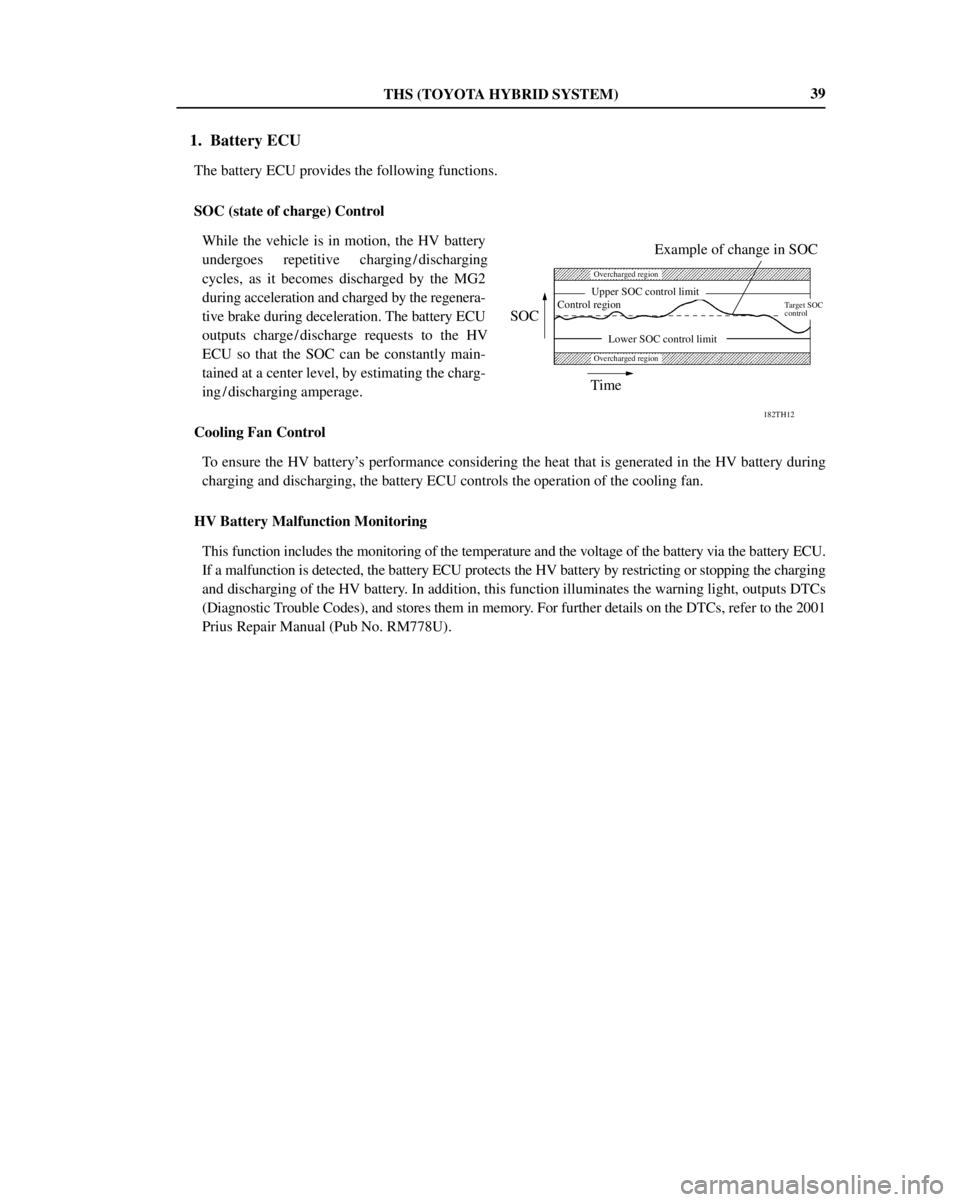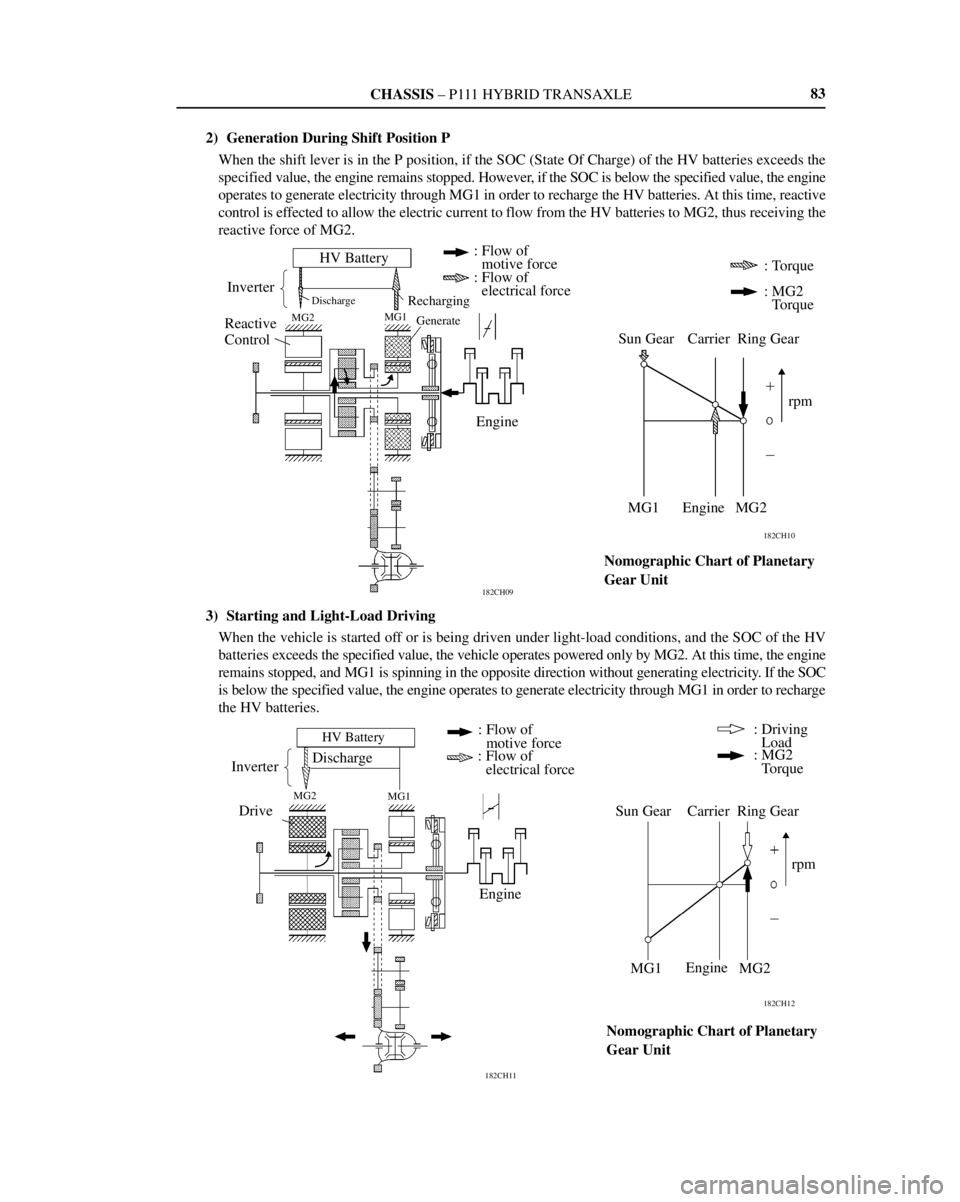Page 330 of 1943

THS (TOYOTA HYBRID SYSTEM)
182TH22
1. READY Light
2. Output Control
Warning Light 3. Master Warning Light
4. Malfunction Indicator light 5. Discharge Warning Light
6. EMPS Malfunction
Warning Light7. HV Battery Warning Light
8. Hybrid System
Malfunction Warning
Light 32
�INDICATOR AND WARNING LIGHT
The warning lights of the Prius are different from those on conventional vehicles. Inspection and repair
should be performed while referring to the troubleshooting section in the 2001 Prius repair manual
(RM778U).
� Center Meter �� Multi Information Display �
1. READY lightTurns on when the ignition switch is turned to START to indicate that the ve-
hicle is ready to drive.
2. Output control
warning lightTurns on when the remaining HV battery charge becomes insufficient at R
range or when there is an abnormal temperature rise in the HV battery due
to continuous driving under heavy loads. It may also light when the HV bat-
tery temperature is low (after starting at low temperatures). The hybrid sys-
tem output is limited while this light is on.
�Travel at reduced speeds (avoid sudden acceleration) while the light is lit.
3. Master warning
lightTurns on with buzzer sounding by linked operation with warning lights ª6º
to ª8º on the multi center display.
4. Malfunction
indicator lightTurns on when there is a malfunction in the engine control system.
5. Discharge warning
lightTurns on when there is a malfunction in the 12 V charging system (converter
assembly).
�If it turns on together with the master warning light and hybrid system
warning light, check the diagnostic code.
6. EMPS malfunction
warning lightTurns on when there is a malfunction in the EMPS control system.
7. HV battery warning
lightTurns on when the HV battery is discharged to the lower limit.
8. Hybrid system
warning lightTurns on when a malfunction in MG1, 2, inverter, HV battery or HV ECU
is detected.
Page 331 of 1943

THS (TOYOTA HYBRID SYSTEM)
182CH05
Stator
Rotor
Speed Sensor (Resolver)
MG1
182CH04
Stator
Rotor
Speed Sensor (Resolver)
MG2
182TH07
N.m
350
300
250
200
150
100
50
0
01000 30002000 50004000 60000 20 40
30
10 kW
Torque
Engine Speed (rpm)Output
Torque
Output
33
MG1 AND MG2 (MOTOR GENERATOR NO.1 AND NO.2)
�DESCRIPTION
�Both the MG1 and the MG2 are compact, lightweight, and highly efficient alternating current permanent
magnet synchronous type.
�Serving as the source of supplemental motive force that provides power assistance to the engine as needed,
the electric motor helps the vehicle achieve excellent dynamic performance, including smooth start-offs
and acceleration. When the regenerative brake is activated, MG2 converts the vehicle's kinetic energy into
electrical energy, which is then stored in the HV battery.
�MG1 recharges the HV battery and supplies electrical power to drive MG2. In addition, by regulating the
amount of electrical power generated (thus varying the generator's rpm), MG1 effectively controls the
continuously variable transmission function of the transaxle. MG1 also serves as the starter to start the
engine.
� MG2 Specifications �
TypePermanent Magnet
Motor (1CM)
Rated voltage [V]273.6
Maximum output [kW] (rpm)33 / (1040 � 5600)
Maximum torque [N.m (kgf.m) (rpm)350 / (0 � 400)
Amperage at maximum torque [A]351
Cooling systemWater-cooled
� Performance Curve �
Page 334 of 1943

THS (TOYOTA HYBRID SYSTEM)
182TH26
Inverter
Converter
182TH17
F. L
MAINF.L DCDC12 V �
Output
Auxiliary
Battery S34B20
Shielded 12 VInverter
SDC273.6 V
DC / DC Converter
Input Filter
20 V
Converter Control Circuit
HV ECU A / C ECUIG
IDH NODD 36
CONVERTER
1. General
The power source for auxiliary equipment of the
vehicle such as the lights, audio system, and the air
conditioner cooling fan, as well as the ECUs, is
based on a 12 V system. Because the THS genera-
tor outputs at 273.6 V, the converter is used to
transform the voltage from DC273.6 V to DC 12
V in order to recharge the auxiliary battery. The
converter is installed on the underside of the in-
verter.
2. Operation
�The DC273.6 V input is initially converted into alternating current by the transistor bridge circuit and
transformed into a low voltage by the transformer. After this, the current is rectified, smoothed (into direct
current) and converted into DC12 V.
�The voltage at the positive terminal of the auxiliary battery is monitored by the converter and is maintained
at a constant level. Consequently, the voltage of the auxiliary battery is unrelated to the engine rpm (even
if the engine is stopped) and to the auxiliary equipment (output current of converter).
Page 335 of 1943
THS (TOYOTA HYBRID SYSTEM)
182TH34
Battery Pack Upper Case
Service Plug
SMR
(System Main Relay)Battery ECU
HV Battery Module37
HV BATTERY
�DESCRIPTION
The sealed nickel metal hydride (Ni-MH) battery technology has been further evolved in the newly devel-
oped HV battery that offers features such as high power density, lightweight, and longevity, that are specifi-
cally designed to match the characteristics of the THS. Because the THS effects charge / discharge control
to maintain a constant level of SOC (state of charge) while the vehicle is operating normally, it does not rely
on the use of external rechargers.
In the battery area, six 1.2-volt cells are connected in series to form one module. A total of 38 modules are
divided into two holders and connected in series. Thus, the HV battery containing a total of 228 cells has a
rated voltage of 273.6 V.
The electrode plates in the HV battery are made of materials such as porous nickel and metal hydride alloy.
Page 337 of 1943

THS (TOYOTA HYBRID SYSTEM)
182TH12
SOCExample of change in SOC
Upper SOC control limit
Control regionTarget SOC
control
Lower SOC control limit
Time
Overcharged region
Overcharged region
39
1. Battery ECU
The battery ECU provides the following functions.
SOC (state of charge) Control
While the vehicle is in motion, the HV battery
undergoes repetitive charging / discharging
cycles, as it becomes discharged by the MG2
during acceleration and charged by the regenera-
tive brake during deceleration. The battery ECU
outputs charge / discharge requests to the HV
ECU so that the SOC can be constantly main-
tained at a center level, by estimating the charg-
ing / discharging amperage.
Cooling Fan Control
To ensure the HV battery's performance considering the heat that is generated in the HV battery during
charging and discharging, the battery ECU controls the operation of the cooling fan.
HV Battery Malfunction Monitoring
This function includes the monitoring of the temperature and the voltage of the battery via the battery ECU.
If a malfunction is detected, the battery ECU protects the HV battery by restricting or stopping the charging
and discharging of the HV battery. In addition, this function illuminates the warning light, outputs DTCs
(Diagnostic Trouble Codes), and stores them in memory. For further details on the DTCs, refer to the 2001
Prius Repair Manual (Pub No. RM778U).
Page 339 of 1943

THS (TOYOTA HYBRID SYSTEM)
182TH20
Cooling FanAir Intake
HV Battery Exhaust Duct No.2Exhaust Duct No.141
HV BATTERY COOLING SYSTEM
�DESCRIPTION
When the temperature of the HV battery rises, the battery ECU executes a command to cause the cooling fan
to operate from OFF to LO, MID and HI speeds. However, if the air conditioning is being used at that time
to cool the vehicle's interior, and if there is still some margin left in the temperature of the HV battery, the
battery ECU keeps the fan OFF or running at LO speed, thus giving priority to the air conditioning.
The air intake for the cooling fan is located above the package tray trim. If an object (such as clothing) is
placed over this area, the HV battery might not be able to cool sufficiently, which could cause the output con-
trol warning light to illuminate.
�CONSTRUCTION
This system feature a cooling fan which is driven by DC motor.
� Specifications �
TypeSirocco Fan
Fan Size Dia x H mm (in.)100 x 40 (4.0 x 1.6)
Motor TypeDC Motor
Lo50
Air Flow Volume m3/hMid100
Hi150
Power Consumption W60
�The operation of the cooling fans is controlled by the signals that are output by the battery ECU, which
monitors the temperature of the HV battery.
Page 345 of 1943

CHASSIS ± P111 HYBRID TRANSAXLE
182CH10
182CH09
: Flow of
: motive force
: Flow of
: electrical force
RechargingInverterHV Battery
Reactive
Control
MG2MG1Generate
EngineSun Gear Carrier Ring Gear
rpm
MG1 Engine MG2
: Torque
: MG2
: Torque
Nomographic Chart of Planetary
Gear Unit
Discharge
182CH12
182CH11
Inverter
HV Battery
Discharge
Drive
MG2
MG1
Engine : Flow of
: motive force
: Flow of
: electrical force
Sun Gear Carrier Ring Gear
rpm
MG1Engine
MG2
Nomographic Chart of Planetary
Gear Unit
: Driving
: Load
: MG2
: Torque
83
2) Generation During Shift Position P
When the shift lever is in the P position, if the SOC (State Of Charge) of the HV batteries exceeds the
specified value, the engine remains stopped. However, if the SOC is below the specified value, the engine
operates to generate electricity through MG1 in order to recharge the HV batteries. At this time, reactive
control is effected to allow the electric current to flow from the HV batteries to MG2, thus receiving the
reactive force of MG2.
3) Starting and Light-Load Driving
When the vehicle is started off or is being driven under light-load conditions, and the SOC of the HV
batteries exceeds the specified value, the vehicle operates powered only by MG2. At this time, the engine
remains stopped, and MG1 is spinning in the opposite direction without generating electricity. If the SOC
is below the specified value, the engine operates to generate electricity through MG1 in order to recharge
the HV batteries.
Page 351 of 1943
CHASSIS ± P111 HYBRID TRANSAXLE
182CH78
Shift Control
Switch
Shift Lock Override LeverShift Lock Solenoid
Shift Lock ECUKey Interlock
Solenoid89
�SHIFT LOCK SYSTEM
1. General
A shift lock system that help prevent the unintended operation of the shift lever has been provided.
The shift lock system consists of a key interlock device and shift lock mechanism.
2. Layout of Components
3. Function of Components
ComponentsFunction
P Position Detection
SwitchDetects whether or not the shift lever is in P position and sends signals to the
shift lock ECU.
Key Interlock SolenoidRegulates the movement of the ignition key cylinder.
Shift Lock SolenoidRegulates the operation of the shift lever at P position.
Stop Light SwitchSends the brake signal to the shift lock ECU.
Shift Lock ECUReceives inputs of various types of signals and regulates the operation of the
two solenoids.